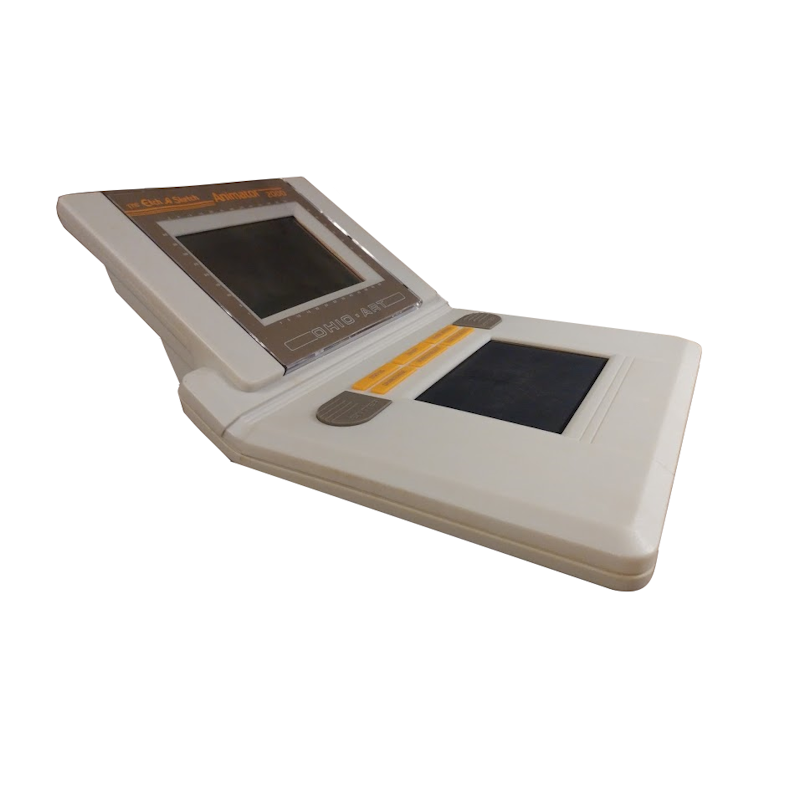|
History
The story of the Etch A Sketch Animator 2000 began with André Cassagnes, a French electrical technician for the Lincrusta Company, a French manufacturer which produced picture frame covers using an aluminum powder. One day, while doing a routine installation of a factory light switch plate, he removed the translucent decal covering the pate and wrote on it with a pencil. He quickly noticed that image transferred to the opposite face of the decal. André Cassagnes knew that he had discovered something, and after a bit of back and forth he concluded that this discovery could be the basis for a toy. In 1959, André unveiled is prototype called “L’Écran Magique” (which translate to Magical Screen) at the Nuremberg Toy Fair in Nuremberg in West Germany. The Ohio Art Company saw the prototype but had no interest in the toy. After a seeing the toy in action the second time, the company decided to take a chance on the product. After a complex series of negotiations, the Ohio Art Company launched the toy in the United States in time for the 1960 Christmas season with the name “Etch A Sketch”. Ohio Art supported the toy with a televised advertising campaign which went on to sell 600,000 units that year.
Over the next few decades, the Etch A Sketch toy was sold in various shape and form, but it wasn’t until 1986 that the toy would drop it’s electromechanical foundation in favor of more modern all-electronic version with the release of the Etch A Sketch Animator. It featured a 40 × 30 dot matrix display and used two knobs for drawing, like a regular Etch A Sketch, with several buttons to manipulate the drawings. It had two kilobytes of memory, capable of storing 12 frames of pictures in any combination up to 96 times. It contained a speaker, which made static-like sounds when the knobs were moved and during animations. At a retail price of about $50, the Animator was one of Ohio Art’s most expensive offerings. The company’s sales jumped 50 percent from about $31.3 million in 1985 to $47 million in 1986, and its profits quintupled to $2.5 million.
In 1987, with the success of The Animator, Ohio decided to work on an updated version of The Animator, known as the Etch A Sketch Animator 2000.
Release
Released a year later in 1988, the updated 2000 version featured a 60×40 LCD screen, 192KB of memory and a custom processor. The two main features of the Animator 2000 were the introduction of a touch pad for drawing instead of the knobs that made the system iconic. The Animator 2000 also feature a cartridges slot. This feature offered many possibilities, including expanded memories, drawings banks and, most importantly, video games. With the North American video game crash that was now over due to the venue of the Nintendo Entertainment System, Ohio thought it would be a good strategy to launch games has their firsts cartridges. Aside a memory expansion cartridges, Ohio released 3 games for the systems : Fly By (a flight simulator game), Overdrive (a road racing game) and Putt-Nuts (a miniature golf game).
Demise
The Animator 2000 had a lot of problem.The introduction of the touch pad was a disappointment for the parents that had grown with the original design. Drawing on the touch pad provided a totally different experience from the original toy and while it was ahead of its time for a video game, didn’t provide the same level of entertainment. As a video game console, the Animator 2000 was also very limited. The games were very basic but the main problem was still the touch pad. While the touch pad was a good way to control games such as Putt-Nuts, it wasn’t great for games that requires precise and or rapid inputs such as Overdrive. The Animator 2000 and the The Animator (which was still being produced) suffered the competition of video game, with Ohio Art losing $3 million in 1989 and 1990 and finally ceased production of the Animator.
Cartridges
Only 3 games were ever produced for the console:
- Fly By, a flight simulator game
- Overdrive, a road racing game
- Putt-Nuts, a miniature golf game.
Each games were sold for USD$28.99.
Sources:
– André Cassagnes on Wikipedia

